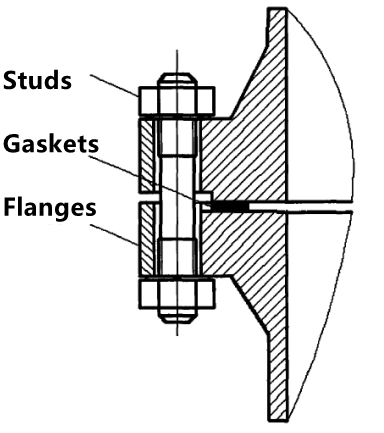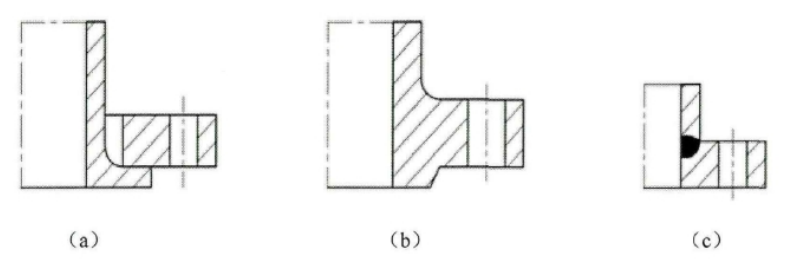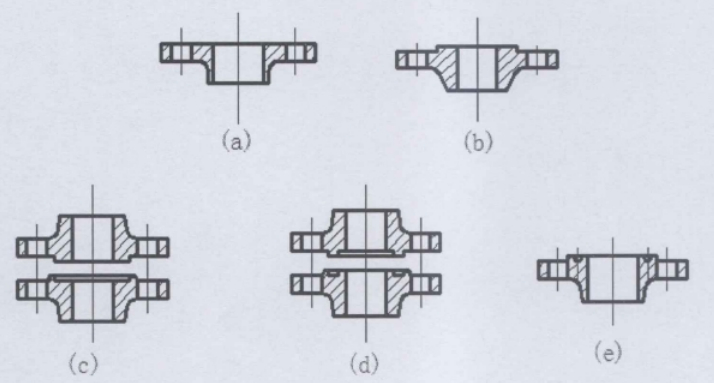An Introduction to Flanges' Connections
Flanges should not only meet the requirements for strength but also leakage rates when working. In addition, they should also have characteristics of convenient assembly and disassembly, low economic costs and good interchangeability.
As shown in the Figure 1-1, the bolted flange is composed of flanges, gaskets, bolts and nuts. The hardness of the gasket should generally be lower than that of the flange. The gasket is compressed by the compression force of the bolt and is deformed so as to fill the uneven gap on the flange's pressing surface, thereby preventing the leakage of fluid to achieve the purpose of sealing.

Figure 1-1 Connection structure of flanges
1.2.1 Forms of flanges
There are many influencing factors for flanges' connections. A flange can be classified in the following ways:
(1) According to the pressure of the working medium
The flange can be divided into external pressure flanges and internal pressure flanges.
(2) According to the shape of the flange
The flange mainly includes round, square and oval shapes. The shape of the flange mainly depends on the shape of the connected part.

Figure 1-2 Flanges with different shapes
(3) Based on the integrity of the flange
A flange can be divided into loose flanges, integral flanges and arbitrary flanges. Their structures are shown in the Figure 1-3 (a), (b), (c).

Figure 1-3 Structure of the flange
Loose flanges fail to effectively connect with the container or pipeline as a whole, and they don't have the same structural strength as an integral connection.
Integral flanges refer to the structure in which the flange, flange neck and container or pipeline are effectively connected together.
An arbitrary flange is a form of flange between the integral flange and loose flange. Some are close to loose flanges, and some are close to integral flanges.
As shown in the Figure 1-1, the bolted flange is composed of flanges, gaskets, bolts and nuts. The hardness of the gasket should generally be lower than that of the flange. The gasket is compressed by the compression force of the bolt and is deformed so as to fill the uneven gap on the flange's pressing surface, thereby preventing the leakage of fluid to achieve the purpose of sealing.

Figure 1-1 Connection structure of flanges
1.2.1 Forms of flanges
There are many influencing factors for flanges' connections. A flange can be classified in the following ways:
(1) According to the pressure of the working medium
The flange can be divided into external pressure flanges and internal pressure flanges.
(2) According to the shape of the flange
The flange mainly includes round, square and oval shapes. The shape of the flange mainly depends on the shape of the connected part.

Figure 1-2 Flanges with different shapes
(3) Based on the integrity of the flange
A flange can be divided into loose flanges, integral flanges and arbitrary flanges. Their structures are shown in the Figure 1-3 (a), (b), (c).

Figure 1-3 Structure of the flange
Loose flanges fail to effectively connect with the container or pipeline as a whole, and they don't have the same structural strength as an integral connection.
Integral flanges refer to the structure in which the flange, flange neck and container or pipeline are effectively connected together.
An arbitrary flange is a form of flange between the integral flange and loose flange. Some are close to loose flanges, and some are close to integral flanges.
(4) Based on the width of the flange's contact surface
The flange can be divided into flanges with narrow faces and wide faces.
Flanges with narrow faces: the contact face of the gasket is located within the circumference of the flange bolt's hole. Flanges with wide faces: the contact surface of the gasket is distributed on the inner and outer sides of the center circle of the flange bolt.
1.2.2 Sealing surfaces of flanges
The flange's sealing surface mainly includes flat faces, raised faces, concave-convex faces, tongue-groove faces and trapezoidal groove faces. Their structures are shown in the Figure 1-4 (a), (b), (c), (d), (e) respectively.
The flat face is a smooth flat surface, sometimes with 2 to 4 small concentric grooves. The bolt force required for the flat sealing surface is great, and the sealing performance is poor, which can be used in situations where the pressure is relatively low and the medium is non-toxic.
The raised face can be used on occasions where the pressure is not high. In order to make the gasket more easily deformed and prevent extrusion, 2 to 4 concentric triangular grooves are generally carved on the sealing surface.
The concave-convex face includes a convex face flange and a concave flange, which can be used for situations with higher pressure. The advantage of this type of sealing surface is that the gasket is easy to center, not easy to be blown off by internal pressure, and the sealing effect is better.
The tongue and groove sealing face include a tongue and a grooved flange. The sealing surface is narrow and requires less bolt force to meet the sealing requirements, which can be used on some important occasions with high pressure and strict sealing requirements.
The trapezoidal sealing surface is also a ring connecting surface. The sealing surface of this structure is used in conjunction with an octagonal gasket or an "O" shaped gasket. The sealing is obtained mainly by the formation of the line contact between the metal ring gasket and sealing surface. This structure has self-tightening ability and reliable sealing, which is used in places with high pressure.

Figure 1-4 The sealing surface of the flange
Flanges with narrow faces: the contact face of the gasket is located within the circumference of the flange bolt's hole. Flanges with wide faces: the contact surface of the gasket is distributed on the inner and outer sides of the center circle of the flange bolt.
1.2.2 Sealing surfaces of flanges
The flange's sealing surface mainly includes flat faces, raised faces, concave-convex faces, tongue-groove faces and trapezoidal groove faces. Their structures are shown in the Figure 1-4 (a), (b), (c), (d), (e) respectively.
The flat face is a smooth flat surface, sometimes with 2 to 4 small concentric grooves. The bolt force required for the flat sealing surface is great, and the sealing performance is poor, which can be used in situations where the pressure is relatively low and the medium is non-toxic.
The raised face can be used on occasions where the pressure is not high. In order to make the gasket more easily deformed and prevent extrusion, 2 to 4 concentric triangular grooves are generally carved on the sealing surface.
The concave-convex face includes a convex face flange and a concave flange, which can be used for situations with higher pressure. The advantage of this type of sealing surface is that the gasket is easy to center, not easy to be blown off by internal pressure, and the sealing effect is better.
The tongue and groove sealing face include a tongue and a grooved flange. The sealing surface is narrow and requires less bolt force to meet the sealing requirements, which can be used on some important occasions with high pressure and strict sealing requirements.
The trapezoidal sealing surface is also a ring connecting surface. The sealing surface of this structure is used in conjunction with an octagonal gasket or an "O" shaped gasket. The sealing is obtained mainly by the formation of the line contact between the metal ring gasket and sealing surface. This structure has self-tightening ability and reliable sealing, which is used in places with high pressure.

Figure 1-4 The sealing surface of the flange
Related News
- Failure Analysis of Cracking in a 16MnⅢ Weld Neck Flange
- ANSYS Analysis for Anchor Flange Structural Optimization
- Flange Leakage in Hydrogen-Cooled Pipeline Systems of Thermal Power Plants
- Flange Sealing Technology and Installation Method for Hydrogenation Units
- Multi-Directional Die Forging Process for Horizontal Valve Bodies with Dual Flanges
- Structural Performance Analysis of Zirconium Pressure Vessel Lap Joint Flanges
- Low-Temperature Flange Sealing Solutions for Cryogenic Chemical Pipelines
- Innovative Technology for Automatic Alignment in Underwater Flange Assembly
- Stamped Steel Slip-On Flanges
- Design and Finite Element Analysis of Anchor Flanges for Oil & Gas Pipelines
